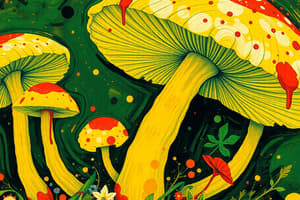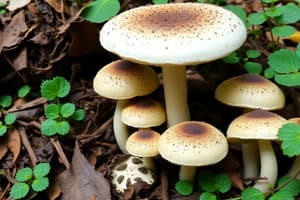Podcast
Questions and Answers
What is the primary effect of amatoxins on human physiology?
What is the primary effect of amatoxins on human physiology?
- Inhibition of RNA polymerase II (correct)
- Activation of pyridoxine-requiring enzymes
- Stimulation of muscarinic receptors
- Inhibition of cytochrome P-450
Which of the following symptoms is most commonly associated with muscarine toxicity?
Which of the following symptoms is most commonly associated with muscarine toxicity?
- Hepatic necrosis
- CNS hyperexcitability
- Renal tubular necrosis
- Abdominal cramps (correct)
What is a significant consequence of reduced GABA concentrations in the brain?
What is a significant consequence of reduced GABA concentrations in the brain?
- Diminished motor coordination
- Enhanced detoxification functions
- Decreased heart rate
- Increased CNS hyperexcitability (correct)
Which toxin primarily affects the renal tubular system while sparing the glomerular apparatus?
Which toxin primarily affects the renal tubular system while sparing the glomerular apparatus?
Which of the following statements about gyromitrins is correct?
Which of the following statements about gyromitrins is correct?
Which of the following best defines a poisonous plant?
Which of the following best defines a poisonous plant?
What time frame is typical for symptoms of muscarine toxicity to begin after ingestion?
What time frame is typical for symptoms of muscarine toxicity to begin after ingestion?
What is the major risk associated with aspiration pneumonia in mushroom poisonings?
What is the major risk associated with aspiration pneumonia in mushroom poisonings?
What is the primary cause of mushroom poisoning in humans?
What is the primary cause of mushroom poisoning in humans?
Which category of mushroom toxicity symptoms appears between 6-24 hours after ingestion?
Which category of mushroom toxicity symptoms appears between 6-24 hours after ingestion?
Which of the following best describes muscimol's mechanism of action?
Which of the following best describes muscimol's mechanism of action?
Which of the following is a characteristic of the pathophysiology of mushroom toxicity?
Which of the following is a characteristic of the pathophysiology of mushroom toxicity?
What type of toxins are associated with poisonous mushrooms?
What type of toxins are associated with poisonous mushrooms?
What is the duration for symptoms classified under the early symptom category of mushroom poisoning?
What is the duration for symptoms classified under the early symptom category of mushroom poisoning?
What is a potential complication of hypoxia described in mushroom poisoning cases?
What is a potential complication of hypoxia described in mushroom poisoning cases?
Which of the following statements about processing mushrooms is correct?
Which of the following statements about processing mushrooms is correct?
What type of symptoms characterizes the delayed symptom category of mushroom poisoning?
What type of symptoms characterizes the delayed symptom category of mushroom poisoning?
Which treatment is recommended for patients with hypoxia and shock following mushroom poisoning?
Which treatment is recommended for patients with hypoxia and shock following mushroom poisoning?
Which complication is specifically associated with norleucine and orellanine poisoning?
Which complication is specifically associated with norleucine and orellanine poisoning?
What role does activated charcoal play in the treatment of mushroom toxicity?
What role does activated charcoal play in the treatment of mushroom toxicity?
Which of the following symptoms is NOT treated with benzodiazepines in mushroom toxicity cases?
Which of the following symptoms is NOT treated with benzodiazepines in mushroom toxicity cases?
What is the conventional treatment for hypoglycemia in mushroom poisoning?
What is the conventional treatment for hypoglycemia in mushroom poisoning?
Which therapeutic approach is primarily indicated for severe hemolytic anemia following mushroom poisoning?
Which therapeutic approach is primarily indicated for severe hemolytic anemia following mushroom poisoning?
In cases where crystalloid and colloid infusions fail, which medication may be necessary to support blood pressure?
In cases where crystalloid and colloid infusions fail, which medication may be necessary to support blood pressure?
What is a common complication of amatoxin and gyromitrin poisonings?
What is a common complication of amatoxin and gyromitrin poisonings?
Which treatment is essential for managing severe poisoning cases exhibiting renal failure?
Which treatment is essential for managing severe poisoning cases exhibiting renal failure?
What is recommended for patients at risk of aspiration following mushroom poisoning?
What is recommended for patients at risk of aspiration following mushroom poisoning?
Which symptom is treated with benzodiazepines in cases of mushroom poisoning?
Which symptom is treated with benzodiazepines in cases of mushroom poisoning?
What effect do multiple doses of activated charcoal have in mushroom poisoning treatment?
What effect do multiple doses of activated charcoal have in mushroom poisoning treatment?
Which electrolyte disturbance can complicate any type of mushroom poisoning?
Which electrolyte disturbance can complicate any type of mushroom poisoning?
What should be administered to treat hypoglycemia in mushroom poisoning cases?
What should be administered to treat hypoglycemia in mushroom poisoning cases?
Which of the following is a complication associated with gyromitrin poisoning?
Which of the following is a complication associated with gyromitrin poisoning?
What is a common reason for mushroom poisoning cases?
What is a common reason for mushroom poisoning cases?
Which category of symptoms appears within the first 6 hours after mushroom ingestion?
Which category of symptoms appears within the first 6 hours after mushroom ingestion?
What is true about the toxins in mushrooms?
What is true about the toxins in mushrooms?
What is a significant effect of amatoxins on cellular processes?
What is a significant effect of amatoxins on cellular processes?
How many mushroom species can potentially cause lethality when ingested?
How many mushroom species can potentially cause lethality when ingested?
What typically influences the severity of mushroom poisoning?
What typically influences the severity of mushroom poisoning?
Which of the following symptoms is primarily associated with muscarine toxicity?
Which of the following symptoms is primarily associated with muscarine toxicity?
Gyromitrins primarily affect which of the following systems?
Gyromitrins primarily affect which of the following systems?
Which of the following is NOT a symptom in the late symptom category of mushroom poisoning?
Which of the following is NOT a symptom in the late symptom category of mushroom poisoning?
Which type of mushroom poisoning symptoms is characterized by nephrotoxic syndromes occurring more than 24 hours after ingestion?
Which type of mushroom poisoning symptoms is characterized by nephrotoxic syndromes occurring more than 24 hours after ingestion?
When does muscarine toxicity typically begin to show symptoms after ingestion?
When does muscarine toxicity typically begin to show symptoms after ingestion?
What is the primary neurotransmitter that is affected by gyromitrins due to pyridoxine inhibition?
What is the primary neurotransmitter that is affected by gyromitrins due to pyridoxine inhibition?
What defines a poisonous plant?
What defines a poisonous plant?
What is a characteristic of the renal effects of 2-Orellanine?
What is a characteristic of the renal effects of 2-Orellanine?
What is the typical time frame for amatoxins to be detected in urine after ingestion?
What is the typical time frame for amatoxins to be detected in urine after ingestion?
What method is often used to manage symptoms of muscarine toxicity?
What method is often used to manage symptoms of muscarine toxicity?
Flashcards
Plant Toxicity
Plant Toxicity
Harmful effects on organisms from plants consumed or contacted in considerable amounts.
Mushroom Poisoning
Mushroom Poisoning
Toxicity from ingesting mushrooms with harmful substances.
Mushroom Toxicity Cause
Mushroom Toxicity Cause
Consumption of toxic mushrooms that resemble edible ones.
Lethal Mushroom Species
Lethal Mushroom Species
Signup and view all the flashcards
Mushroom Toxicity Severity
Mushroom Toxicity Severity
Signup and view all the flashcards
Mushroom Poisoning Categories
Mushroom Poisoning Categories
Signup and view all the flashcards
Early Mushroom Poisoning
Early Mushroom Poisoning
Signup and view all the flashcards
Mushroom Toxins
Mushroom Toxins
Signup and view all the flashcards
Gyromitrins
Gyromitrins
Signup and view all the flashcards
Amatoxins
Amatoxins
Signup and view all the flashcards
Renal tubular necrosis
Renal tubular necrosis
Signup and view all the flashcards
Muscimol/Ibotenic Acid
Muscimol/Ibotenic Acid
Signup and view all the flashcards
Muscarine
Muscarine
Signup and view all the flashcards
GABA Agonists
GABA Agonists
Signup and view all the flashcards
Hepatic Necrosis
Hepatic Necrosis
Signup and view all the flashcards
Aspiration Pneumonia
Aspiration Pneumonia
Signup and view all the flashcards
Mushroom Poisoning Complications
Mushroom Poisoning Complications
Signup and view all the flashcards
Hepatic Failure in Mushroom Poisoning
Hepatic Failure in Mushroom Poisoning
Signup and view all the flashcards
Renal Failure in Mushroom Poisoning
Renal Failure in Mushroom Poisoning
Signup and view all the flashcards
Convulsions from Mushroom Poisoning
Convulsions from Mushroom Poisoning
Signup and view all the flashcards
Mushroom Poisoning Treatment: Fluid Resuscitation
Mushroom Poisoning Treatment: Fluid Resuscitation
Signup and view all the flashcards
Mushroom Poisoning Treatment: Gut Decontamination
Mushroom Poisoning Treatment: Gut Decontamination
Signup and view all the flashcards
Mushroom Poisoning Treatment: Activated Charcoal
Mushroom Poisoning Treatment: Activated Charcoal
Signup and view all the flashcards
Mushroom Poisoning Treatment: Hypoglycemia
Mushroom Poisoning Treatment: Hypoglycemia
Signup and view all the flashcards
Plant Toxicity
Plant Toxicity
Signup and view all the flashcards
Mushroom Poisoning Cause
Mushroom Poisoning Cause
Signup and view all the flashcards
Mushroom Poisoning Severity
Mushroom Poisoning Severity
Signup and view all the flashcards
Mushroom Poisoning Categories
Mushroom Poisoning Categories
Signup and view all the flashcards
Early Mushroom Poisoning
Early Mushroom Poisoning
Signup and view all the flashcards
Mushroom Toxins
Mushroom Toxins
Signup and view all the flashcards
Amatoxin
Amatoxin
Signup and view all the flashcards
Mushroom Poisoning Treatment
Mushroom Poisoning Treatment
Signup and view all the flashcards
Gyromitrin Toxicity
Gyromitrin Toxicity
Signup and view all the flashcards
Amatoxin Action
Amatoxin Action
Signup and view all the flashcards
Renal Tubular Necrosis
Renal Tubular Necrosis
Signup and view all the flashcards
GABA Agonists
GABA Agonists
Signup and view all the flashcards
Muscarinic Receptor Stimulation
Muscarinic Receptor Stimulation
Signup and view all the flashcards
Mushroom Poisoning Symptoms
Mushroom Poisoning Symptoms
Signup and view all the flashcards
Aspiration Pneumonia Risk
Aspiration Pneumonia Risk
Signup and view all the flashcards
Muscimol/Ibotenic Acid Effect
Muscimol/Ibotenic Acid Effect
Signup and view all the flashcards
Mushroom Poisoning Complications
Mushroom Poisoning Complications
Signup and view all the flashcards
Hepatic Failure Treatment
Hepatic Failure Treatment
Signup and view all the flashcards
Renal Failure in Mushroom Poisoning
Renal Failure in Mushroom Poisoning
Signup and view all the flashcards
Convulsions in Mushroom Poisoning
Convulsions in Mushroom Poisoning
Signup and view all the flashcards
Mushroom Poisoning Treatment: Fluid Resuscitation
Mushroom Poisoning Treatment: Fluid Resuscitation
Signup and view all the flashcards
Gut Decontamination (Mushroom Poisoning)
Gut Decontamination (Mushroom Poisoning)
Signup and view all the flashcards
Activated Charcoal in Mushroom Poisoning
Activated Charcoal in Mushroom Poisoning
Signup and view all the flashcards
Hypoglycemia Treatment in Poisoning
Hypoglycemia Treatment in Poisoning
Signup and view all the flashcards
Study Notes
Plant Toxicity
- A poisonous plant is one that causes harm or death when ingested or touched in sufficient amounts.
- Examples include mushrooms, foxglove, castor bean, and tobacco.
Mushroom Poisoning
- Mushrooms are the fruiting bodies of fungi.
- Mushroom toxicity may result from ingesting mushrooms containing similar-looking but toxic substances.
- Thousands of mushroom species exist, but only about 100 cause human symptoms, and 15-20 are potentially fatal.
- There's no simple way to distinguish edible from poisonous mushrooms.
- Misidentification is the cause of over 95% of mushroom poisoning cases.
Pathophysiology
- Each toxic mushroom contains one or more toxins.
- Toxicity severity depends on:
- The mushroom's origin location.
- The toxin's amount consumed.
- The mushroom's genetic characteristics.
- Cooking, boiling, and freezing don't always reduce toxicity.
Mushroom Poisoning Categories
- Mushroom poisoning can be categorized based on symptom onset timing:
- Early symptoms (within 6 hours): gastrointestinal, allergic, and neurologic syndromes
- Late symptoms (6-24 hours after ingestion): hepatotoxic and nephrotoxic syndromes
- Delayed symptoms (more than 24 hours): mostly nephrotoxic syndromes
Mushroom Toxins
- Toxins include:
- Amatoxins (Cyclopeptides): Powerful, even low doses (0.1 mg/kg) can be lethal. A single, fully grown poisonous mushroom can contain potentially lethal amounts (5-8 mg). These are cyclic octapeptides produced by Amanita species and rapidly absorbed. They can be detected in urine quickly (90-120 minutes). The most significant human toxin is alpha-amatoxin, which inhibits RNA polymerase II and protein synthesis.
- Gyromitrins (Monomethylhydrazine): Inhibit various hepatic systems, including cytochrome P-450 and glutathione, and cause hepatic necrosis. Inhibit pyridoxine-requiring enzymes (GABA) leading to nervous system hyperexcitability and seizures.
- Orellanine: Primarily affects the renal tubules, causing necrosis without significant damage to the glomeruli.
- Muscimol and Ibotenic Acid: Structurally similar to GABA, they act as agonists, leading to nervous system effects.
- Norleucine (Nephrotoxins): Cause primarily renal failure.
- Muscarine: Stimulates postganglionic cholinergic receptors, causing parasympathetic overstimulation—symptoms like sweating, flushing, salivation, lacrimation, nausea, vomiting, diarrhea, and miosis.
Complications of Mushroom Toxicity
- Respiratory: Aspiration pneumonia due to loss of airway protective reflexes.
- Neurologic: Seizures, hypoxia, acidosis, and cerebral edema.
- Hepatic: Hepatic failure and hypoglycemia (associated with amatoxin and gyromitrin poisonings)
- Renal: Renal failure, often associated with norleucine and orellanine poisoning. Also from hypoperfusion and shock.
- Hematologic: Methemoglobinemia and hemolysis (with gyromitrin poisoning).
- Others: Trauma, hypovolemia, and electrolyte imbalances (often with hallucinogenic mushrooms).
Treatment of Mushroom Toxicity
- General measures: Early volume resuscitation (fluid replacement), gut decontamination (e.g., whole-bowel irrigation), multiple doses of activated charcoal to interrupt enterohepatic circulation.
- Endotracheal intubation and mechanical ventilation: For those at risk of aspiration or with hypoxia, acidosis, and shock.
- Specific treatments:
- Agitation: Benzodiazepines.
- Severe muscarinic symptoms: Atropine infusions
- Disulfiram-containing mushrooms: Fomepizole (blocks alcohol dehydrogenase)
- Renal failure: Hemodialysis.
- Blood transfusions: In cases of fluid overload, severe hyperkalemia, acidosis, hemorrhagic diarrhea, blood loss, and severe hemolytic anemia).
- Blood pressure support: Dopamine and norepinephrine (when other fluids fail).
- Hypoglycemia: 10% dextrose infusions.
Studying That Suits You
Use AI to generate personalized quizzes and flashcards to suit your learning preferences.




